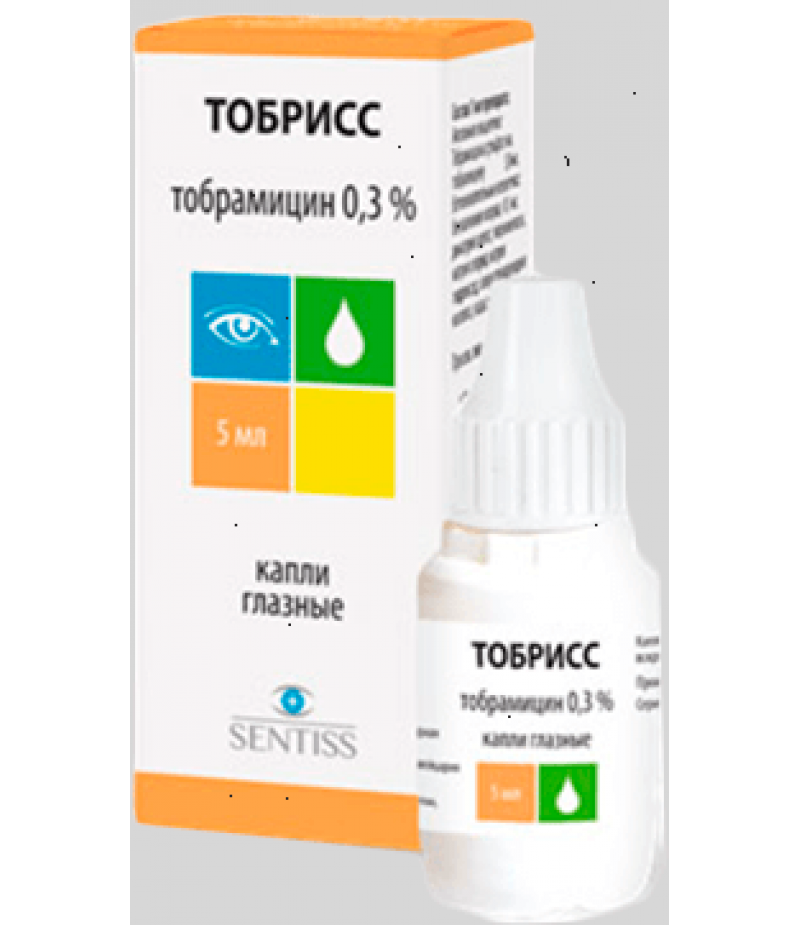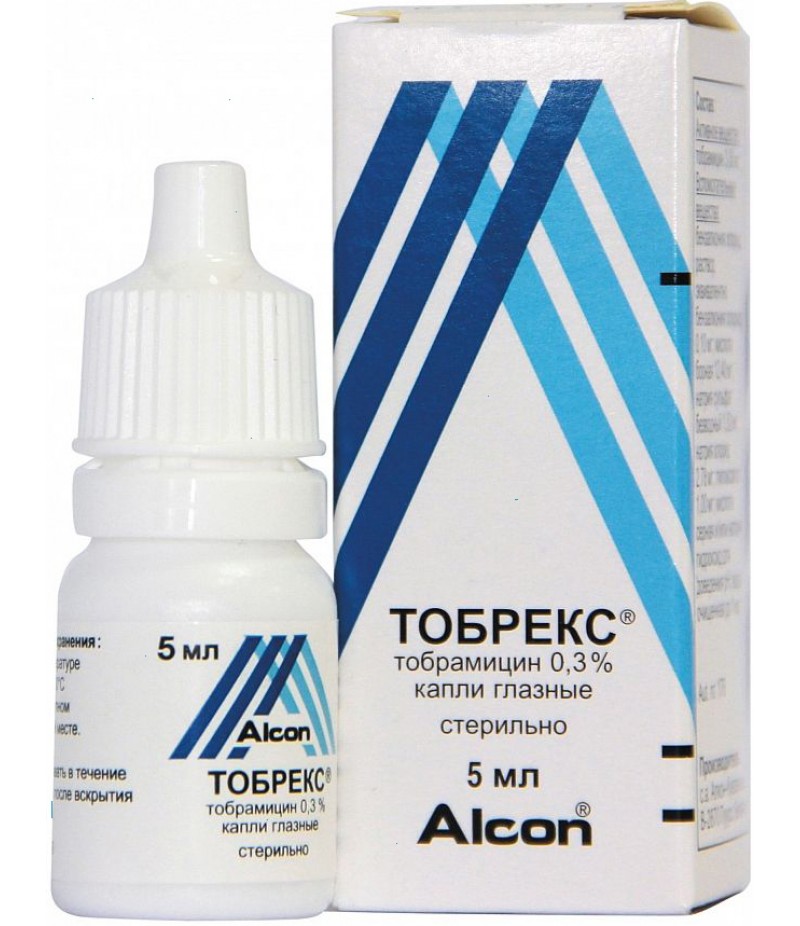Tobris drops 0.3% 5ml
- $9.95
- 3 or more $9.80
- Availability:In Stock
Tobris user manualReed more and buy Tobris drops on this pageThe drug Tobris is a broad-spectrum antibiotic from the aminoglycoside group. At low concentrations, it acts bacteriostatically (blocks the 30S subunit of the ribosome a..
Tags: drops
Tobris user manual
Reed more and buy Tobris drops on this page
The drug Tobris is a broad-spectrum antibiotic from the aminoglycoside group. At low concentrations, it acts bacteriostatically (blocks the 30S subunit of the ribosome and breaks down the synthesis of the protein), and at higher bactericidal levels (it breaks the protein synthesis and permeability of the cytoplasmic membrane of the microbial cell, causing its death).
Tobramycin sensitive microorganisms: Aerobic Gram-positive microorganisms: Corynebacterium, Staphylococcus aureus (sensitive to methicillin); coagulase-negative types of staphylococci (sensitive to methicillin, including penicillin-resistant strains). Gram-negative bacteria: Acinetobacter species; Escherichia coli; Haemophilus influenzae; species of Klebsiella; Moraxella species; Morganella morganii; Pseudomonas aeruginosa.
Tobramycin-resistant microorganisms: Aerobic Gram-positive microorganisms: some Staphylococcus species resistant to methicillin with a incidence of resistance to 50% of all staphylococcus species in some European countries; Streptococcus pneumoniae and most strains of streptococcus group D.
Some gentamycin resistant strains retain high sensitivity to tobramycin.
The emergence of resistance to tobramycin is the result of modification and inactivation of antibiotics by enzymes present in the periplasmic space of bacteria. There are three different mechanisms by which aminoglycosides are inactivated: acetylation of amino groups, phosphorylation of hydroxyl groups and adenylation of hydroxyl groups.
Variable sensitivity between aminoglycoside antibiotics against other classes of modified enzymes is also possible. The most common mechanism of acquired resistance to aminoglycosides is the inactivation of the antibiotic by modifying plasmids and transposon-encoded enzymes.
Below are the critical values of the minimum inhibitory concentration (MIC) that separate sensitive microorganisms S (MIC <4 mg / ml) from conditionally sensitive microorganisms and conditionally sensitive microorganisms from resistant, R (resistant) ≥8 mg / ml. Resistance can vary geographically for the corresponding species of microorganisms, so it is desirable to have local information on resistant microorganisms, especially when treating severe infections.
Pharmacokinetics of Tobris
With topical application, systemic absorption is low. Tobramycin poorly penetrates the cornea, and its concentration in aqueous humor after local application of 0.3% solution is not determined. Increasing the frequency of application can increase the concentration of tobramycin in aqueous humor.
Indications for use
Drops of Tobris are used to treat infectious diseases of the anterior segment of the eyeball caused by microorganisms sensitive to tobramycin, in adults and children older than 2 months.
Mode of application
In case of easy flow of the infectious process, 1 drop of Tobris in the conjunctival sac 2 times a day (morning and evening) for 7 ± 1 days. In the case of a severe course of the infectious process on the first day, 1 drop 4 times a day during the waking period, and then 1 drop to the affected eye twice a day during waking, the total treatment period is 7 ± 1 days.
To prevent contamination of the tip of the vial and solution, avoid contact with the eyelids, the peri-ocular area or other surfaces. After use, it is necessary to close the bottle tightly.
In the case of joint application with other medicines for topical application in ophthalmology, an interval of 5-10 minutes between instillations should be observed.
Application in the elderly
Do not require dose adjustment when used in the elderly.
Use in the pediatric population
The use of eye drops of tobramycin in patients older than 2 months in the same dosages as in adults is possible. The efficacy and safety of the drug in patients younger than 2 months is not established.
Patients with renal and hepatic insufficiency
With topical application of tobramycin, its low system exposure is noted. In the case of combined use with systemic aminoglycoside antibiotics, it is necessary to monitor their level in the plasma to maintain the required systemic concentrations.
Side effects of Tobris
The most common adverse events with the use of Tobriss were toxicity and local hypersensitivity, including itchy eyelids, eyelid edema, lacrimation, conjunctival injection.
Information on adverse events was obtained during clinical trials and post-registration experience of the drug and classified according to the following grading frequency: very often (≥1 / 10), often (from ≥1 / 100 to <1/10), infrequently (from ≥ 1 / 1,000 to <1/100), rarely (from ≥1 / 10,000 to <1 / 1,000), very rarely (<1/10,000), with an unknown frequency (the frequency of occurrence can not be determined from the available data). In each group of adverse events grouped according to the frequency of occurrence, adverse events are presented in descending order of severity.
Impaired immune system. Infrequent: hypersensitivity.
Violations from the nervous system. Infrequently: a headache.
Disorders from the side of the organ of sight. Often: discomfort in the eye, conjunctival injection, allergic phenomena from the side of the eye, itchy eyelids; infrequently: keratitis, corneal erosion, visual impairment, blurred vision, erythema of eyelids, discharge from the eyes, edema of the conjunctiva, eyelid edema, pain in the eye, dry eye syndrome, itching in the eye, lacrimation; with an unknown frequency: eye irritation.
Disturbances from the skin and subcutaneous fat. Infrequent: urticaria, dermatitis, madarose, leukoderma, itching, dry skin; with an unknown frequency: rash, erythema.
Contraindications
Contraindications to the use of drops of Tobris are: hypersensitivity to the components of the drug, the period of breastfeeding, children under 2 months.
Pregnancy
When oral use of Tobris at doses much higher than those for application in the form of instillations, the phenomena of nephro- and ototoxicity are noted. Tobramycin, when administered orally, penetrates the placenta into amniotic fluid and fetal blood. In a study of the parenteral use of antibiotics-aminoglycosides, including tobramycin, no risks to the fetus were noted. No high level of tobramycin in the plasma is expected after application as instillations.
Information about the use of the drug in the therapy of pregnant women is absent or limited. In animal studies, information has been obtained on reproductive toxicity. It is not recommended to use the drug during pregnancy.
Tobramycin is excreted in breast milk in a significant amount when administered orally and parenterally. When applied as instillations, the system exposure of the drug is low, which makes it unlikely that excretion of tobramycin into breast milk. It is necessary to stop breastfeeding or interrupt / discontinue drug therapy, taking into account the benefits of therapy for the mother and the benefits of breastfeeding for the baby.
Interaction Tobris with other drugs
Studies of the interaction of the drug Tobris with other drugs have not been conducted. With the combined use of ophthalmic forms of tobramycin and corticosteroids for topical application in ophthalmology, clinical symptoms of bacterial, fungal and viral diseases of the eye can be masked, and hypersensitivity reactions can be suppressed.
Overdose
Do not expect toxic effects with a local ophthalmic application of the drug Tobris or in case of accidental ingestion of the contents of the vial. Clinical manifestations of an overdose with tobramycin in the form of instillations (including point keratitis, erythema eyelids, lacrimation, edema of the conjunctiva, itching of the eyelids) may be similar to the undesirable phenomena observed in a number of patients during treatment with the drug.
Storage conditions
At a temperature of no higher than 30 ° C in a dark place. Do not freeze.
Keep out of the reach of children.
Form of issue
Tobris - drops of eye 0,3%.
5 ml in a plastic bottle-dropper with a screw cap. Each vial-dropper along with the instruction for use is placed in a cardboard box.
Composition
1 ml of the drug Tobris contains the active substance: tobramycin-3 mg.
Excipients: benzalkonium chloride 0.1 mg, hypromellose 2.5 mg, disodium edetate 1.0 mg, sodium chloride 9.0 mg, sodium hydroxide or hydrochloric acid to pH 7.5, water for injection up to 1 ml.
Terms of sell
To buy Tobris you don't need a prescription.
Additionally
Only for topical application in ophthalmology. The preparation of Tobris is not intended for use in the form of injections or oral administration.
Hypersensitivity to aminoglycosides for topical application in ophthalmology has been noted in a number of patients. When the symptoms of hypersensitivity develop, the drug should be discontinued. Cross-sensitivity to other aminoglycosides has been noted, therefore it must be taken into account that hypersensitivity to tobramycin may lead to hypersensitivity to other aminoglycosides for local or systemic use.
There were serious adverse reactions, such as neurotoxicity, ototoxicity and nephrotoxicity, with oral administration of tobramycin. Care must be taken when combined with other aminoglycosides. As with long-term use of other antibiotics, excessive growth of microorganisms insensitive to tobramycin, including fungi, is possible. In case of development of superinfection, the use of the drug should be stopped.
It is not recommended to wear contact lenses during the treatment of infectious diseases of the organ of vision.
The composition of the drug includes benzalkonium chloride, which can cause eye irritation and discoloration of soft contact lenses. Avoid contact with soft contact lenses. Patients should be instructed to remove contact lenses before using the drug and re-donning them no earlier than 15 minutes after instillation.


